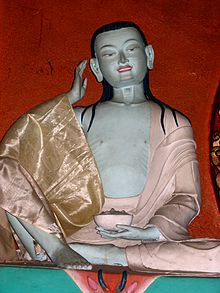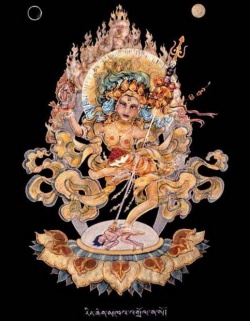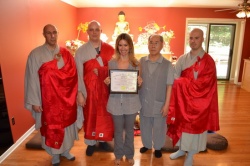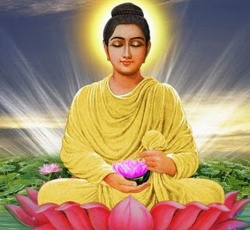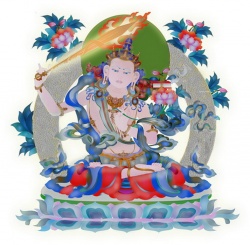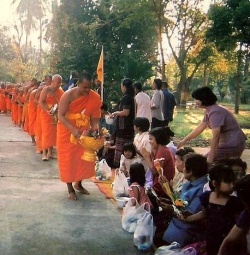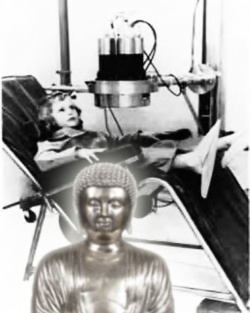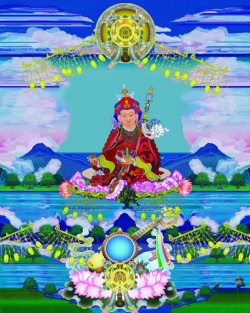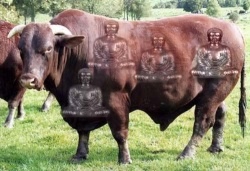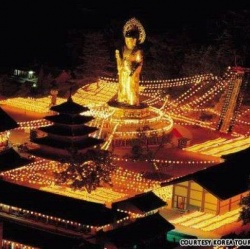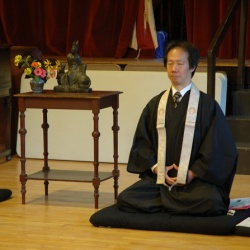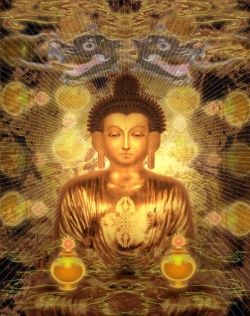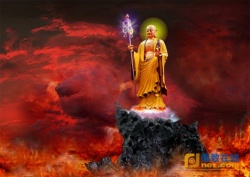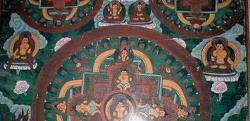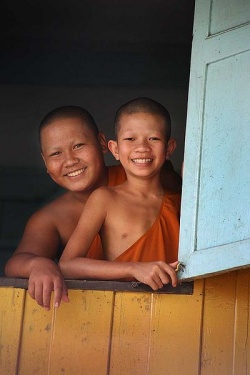Difference between revisions of "Origin and History of Tibetan Medicine"
| Line 73: | Line 73: | ||
[[Tibetan medicine]] is another patrimony for [[humanity]]. It did not develop only at the [[physical]], material level, such as {{Wiki|Western}} [[medicine]], but considers the [[person]] as a whole of [[body]], [[energy]], and [[mind]]. As I have already said, in a diagnosis from the beginning you have to check whether there are negative provocations or not. It is easier to identify negative provocations in their material aspect. But there are also many aspects relating to [[energy]] and that, usually, we call [[black magic]]. In general we ignore how our [[dimension]], our situation, is. | [[Tibetan medicine]] is another patrimony for [[humanity]]. It did not develop only at the [[physical]], material level, such as {{Wiki|Western}} [[medicine]], but considers the [[person]] as a whole of [[body]], [[energy]], and [[mind]]. As I have already said, in a diagnosis from the beginning you have to check whether there are negative provocations or not. It is easier to identify negative provocations in their material aspect. But there are also many aspects relating to [[energy]] and that, usually, we call [[black magic]]. In general we ignore how our [[dimension]], our situation, is. | ||
| − | For example, when we say that there are [[spirits]], local guardians, and so on, many [[people]] say they do not believe it because they have never seen them. That is not [[logical]], and this is also confirmed by a very high level [[scholar]] in the [[Sakyapa tradition]], Sakyapandita. You cannot see the {{Wiki|past}} or the {{Wiki|future}}, but you cannot deny them. You cannot see something that is far away. [[Science]] explains that it takes {{Wiki|light}} many years to get to us. We cannot see where it comes from, but if we look at the night sky we can see how many {{Wiki|stars}} there are. We know that the {{Wiki|stars}} are [[constellations]], {{Wiki|solar}} systems, [[infinite]] {{Wiki|dimensions}}, so if there are [[infinite]] {{Wiki|dimensions}} why should [[countless]] types of [[sentient beings]] not [[exist]] as well? [[Beings]] with very high capacity and [[beings]] who are very weak. If we provoke them, those with higher capacities can send us a lot of negativity and this is what is called negative provocations. Sometimes they are directed at the family, who will pay to the [[end]] of the generation. We do not know how we provoke them because there are [[sentient beings]] that we can see and others that we cannot. If we walk in a garden we can see many small [[animals]]: some may see us, others do not. This is an example of the fact that there are [[beings]] with far more power than us, but that we cannot see: if we provoke them, of course they can send us some negativity. If we provoke a small [[animal]], like a {{Wiki|mouse}}, for example, it will at least try to bite us, it will provoke us in this way, while if it is larger, then the provocation will be much heavier. | + | For example, when we say that there are [[spirits]], local guardians, and so on, many [[people]] say they do not believe it because they have never seen them. That is not [[logical]], and this is also confirmed by a very high level [[scholar]] in the [[Sakyapa tradition]], [[Sakyapandita]]. You cannot see the {{Wiki|past}} or the {{Wiki|future}}, but you cannot deny them. You cannot see something that is far away. [[Science]] explains that it takes {{Wiki|light}} many years to get to us. We cannot see where it comes from, but if we look at the night sky we can see how many {{Wiki|stars}} there are. We know that the {{Wiki|stars}} are [[constellations]], {{Wiki|solar}} systems, [[infinite]] {{Wiki|dimensions}}, so if there are [[infinite]] {{Wiki|dimensions}} why should [[countless]] types of [[sentient beings]] not [[exist]] as well? [[Beings]] with very high capacity and [[beings]] who are very weak. If we provoke them, those with higher capacities can send us a lot of negativity and this is what is called negative provocations. Sometimes they are directed at the family, who will pay to the [[end]] of the generation. We do not know how we provoke them because there are [[sentient beings]] that we can see and others that we cannot. If we walk in a garden we can see many small [[animals]]: some may see us, others do not. This is an example of the fact that there are [[beings]] with far more power than us, but that we cannot see: if we provoke them, of course they can send us some negativity. If we provoke a small [[animal]], like a {{Wiki|mouse}}, for example, it will at least try to bite us, it will provoke us in this way, while if it is larger, then the provocation will be much heavier. |
So when there is a negative provocation in the {{Wiki|illness}}, it is important to know how to control it. For example, for curing we also use [[mantras]], words that contain a high potentiality and produce it through [[sound]]. After receiving [[transmission]] of them, by reciting them we can produce their [[function]]. This is one of the therapies, still in use today, of the [[ancient]] [[Bön tradition]] that was also using different kinds of [[rites]]. The [[ancient]] [[Bön tradition]] is very different from {{Wiki|modern}} [[Bön]]. | So when there is a negative provocation in the {{Wiki|illness}}, it is important to know how to control it. For example, for curing we also use [[mantras]], words that contain a high potentiality and produce it through [[sound]]. After receiving [[transmission]] of them, by reciting them we can produce their [[function]]. This is one of the therapies, still in use today, of the [[ancient]] [[Bön tradition]] that was also using different kinds of [[rites]]. The [[ancient]] [[Bön tradition]] is very different from {{Wiki|modern}} [[Bön]]. | ||
| Line 85: | Line 85: | ||
I also wrote another [[book]] called The Light of [[Kailash]] ([[ti se’i ’od zer]]), in which I have divided the history of [[Tibet]] into three eras: the epoch of [[Shang Shung]], the epoch of [[Shang Shung]] and [[Tibet]], and the epoch of [[Tibet]]. This is my way of doing research. | I also wrote another [[book]] called The Light of [[Kailash]] ([[ti se’i ’od zer]]), in which I have divided the history of [[Tibet]] into three eras: the epoch of [[Shang Shung]], the epoch of [[Shang Shung]] and [[Tibet]], and the epoch of [[Tibet]]. This is my way of doing research. | ||
| − | The first is the epoch of [[Shang Shung]]. In that period the [[Tibetan]] {{Wiki|kingdom}} did not [[exist]], and the [[Tibetan people]] were divided in different tribes. But [[Shang Shung]] was very powerful at that [[time]], it also dominated the [[Shang Shung]] [[Phugpa]], today’s Tagikistan and Kirgistan, countries that are now under {{Wiki|Russia}}. In the history [[books]] of the [[Bön tradition]] they speak very much of [[Tazig]]. This is the actual Tagikistan, it is not {{Wiki|Persia}}, as many [[people]] think, it has nothing to do with {{Wiki|Persia}}. There was a very important [[teacher]] of [[Shang Shung]], a [[Bönpo]] [[teacher]] called [[Trenpa Namkha]]. There were three [[Trenpa]] | + | The first is the epoch of [[Shang Shung]]. In that period the [[Tibetan]] {{Wiki|kingdom}} did not [[exist]], and the [[Tibetan people]] were divided in different tribes. But [[Shang Shung]] was very powerful at that [[time]], it also dominated the [[Shang Shung]] [[Phugpa]], today’s [[Tagikistan]] and [[Kirgistan]], countries that are now under {{Wiki|Russia}}. In the history [[books]] of the [[Bön tradition]] they speak very much of [[Tazig]]. This is the actual [[Tagikistan]], it is not {{Wiki|Persia}}, as many [[people]] think, it has nothing to do with {{Wiki|Persia}}. There was a very important [[teacher]] of [[Shang Shung]], a [[Bönpo]] [[teacher]] called [[Trenpa Namkha]]. There were three [[Trenpa Namkhas]]. The first one was from [[Tazig]], [[Tagikistan]]: he became [[student]] of [[Tonpa Shenrab]] and became a very important [[teacher]] of the [[Bön]]. After he passed away, since he had been an important [[teacher]], another [[scholar]] from [[Shang Shung]] received the [[name]] [[Trenpa Namkha]]. This is the [[Trenpa Namkha]] of [[Shang Shung]]. |
Also in the [[time]] of [[Guru Padmasambhava]] in [[Tibet]], among his twenty-five students there was one called [[Lachen Trenpa Namkha]] who was originally [[Bön]]: this is the [[Trenpa Namkha]] of [[Tibet]]. | Also in the [[time]] of [[Guru Padmasambhava]] in [[Tibet]], among his twenty-five students there was one called [[Lachen Trenpa Namkha]] who was originally [[Bön]]: this is the [[Trenpa Namkha]] of [[Tibet]]. | ||
Revision as of 00:38, 10 December 2014
Good evening everyone and everywhere. Here we are in Tenerife, starting today our programs of Tibetan culture. This year they are especially dedicated to the medical field. You will have the occasion to learn something; this is really a good opportunity. In these days we have distinguished medical professionals guests from Tibet so I will not talk about medicine.
Instead, I would like to explain a little about the background of Tibetan culture, because this may be useful to understand why it is important to learn a little about the various fields it includes, such as history, medicine, astrology, and so on. As you all know Tibet is called the Land of Snows and also the roof of the world because it is situated in the Himalayas. This has created a special condition: while, on the one hand, its isolation has not favored material development as has happened in other countries, on the other hand it has allowed ancient culture and knowledge to remain intact and be handed down over the centuries.
Let me give you the example of the Buddhist tradition. Buddhism, all the teachings of Sutra and Tantra, were developed in India and in the country of Oddiyana. Already in ancient times the Tibetans showed great interest in the spiritual path. Since development and communications at the physical level were not very easy, they dedicated themselves more to the spiritual path, which was of course very developed, just like in India and Oddiyana. Many Tibetan scholars made sacrifices to go to India and Oddiyana to study and translate the ancient texts and to invite to Tibet important masters who developed and enriched the spirituality of Tibet. Today, if we consider ancient cultures and knowledge, the richest spiritual path is in Tibet, also thanks to its geographic isolation.
When we organize an event about Tibetan culture many people might think that we are doing it because Namkhai Norbu is Tibetan and likes his culture, but it is not the only reason. Tibetan culture has great value for the whole world, not only for the Tibetans. It is important that people understand this. That is why last year we organized a ten-day cultural event on Tibet and we were very pleased with the enthusiastic participation of people and the fact that the local authorities worked with us in the organization. This is something important for all of us citizens of the world.
In general, official history traces the culture and knowledge of India and China back four thousand years and we consider this very ancient time. But the history and the culture of Tibet also date from the same period. I worked for nearly thirty years at the University and in the last years I dedicated myself particularly to research on Tibetan culture and history and found out that they are very old, almost as old as Indian and Chinese. For example, the Buddhist tradition is widespread in Tibet, but before this there was a pre-Buddhist tradition, a kind of religion called Bön. How did it develop? We consider that its founder was Tonpa Shenrab, and we find explanations of the Bön tradition from him. From here we can understand how Tibetan culture developed originally.
The majority of Western scholars follow the Tibetan Buddhist tradition, the way that history is presented by Buddhism. But this does not reflect the real situation of Tibet. To know about the history of ancient Tibet we have to go into the field of the Bön tradition because Buddhism began much later, with the generations of the Tibetan kings. According to the history of the Bön tradition, before the famous king Songtsen Gampo there were thirty-two generations of Tibetan kings. Traditionally it is considered that the origin of Tibetan history coincides with the coronation of the first Tibetan king, but this is not so, it is much earlier, around the time of the famous “Miu dung trug,” the story of six brothers, which is considered to be the origin of the Tibetans and which both the ancient tradition and the Buddhist agree upon. But where were these six brothers from? The Buddhist interpretation is different from that of the ancient Bön tradition. The latter, for example, presents the origin of humanity as the cosmic egg. Some scholars believe that this tradition is Hindu, but the fact that this explanation exists in Hindu Shaivism does not imply that it has originated in Hinduism. Why? The Shaivas consider that the most important sacred place is Mount Kailash. Even today many of them make sacrifices to go to Tibet to visit and circumambulate it. Therefore Shaivism does not come first but rather Kailash. And Kailash is in Tibet, not in India. So when they speak of the cosmic egg, there is no contradiction.
“Cosmic Egg” is how the five elements are put together and how countries, beings, and so on developed from these. This is explained in the ancient Bön tradition. When I started doing this kind of research I wrote a book called The Necklace of Jewels (Norbu Doshal), which is published in India. In it I explained very clearly what it meant by cosmic egg and that there is no contradiction. In the ancient Bön tradition it says that all beings came from the cosmic egg, that human beings developed from the three original groups of gods, nagas, and nyen. The Unique Volume of the Lang Clan (Rlangs kyi po ti bse ru rgyas pa), a very ancient history of Tibet, explains the origin of human beings, and in particular the Tibetans, with the cosmic egg and six brothers from whom the six Tibetan tribes originated. Among these, two had particular significance for the history of Tibet: one tribe prospered and ruled western Tibet, which is the region called Shang Shung, while the other scattered in eastern Tibet. The first tribe, named Khyung, had more advanced understanding because as the Bön tradition affirms, the famous Bön teacher Tonpa Shenrab created the Shang Shung writing, which did not exist previously. Therefore, the history of Shang Shung also began from the time of Tonpa Shenrab, while, at the time, Tibet did not exist yet. The other tribes of the six brothers, for example, were very strong physically and they had a history, but writing only developed in Western Tibet. Therefore, to study the origin of Tibetan history and culture we must go back to that.
In Tibet, in general, the most widespread tradition states that Tibetan writing developed in the time of Songtsen Gampo and that before him there was none. This is true, there was no Tibetan writing, but it does not mean that the Tibetans did not use a form of writing, they used that of Shang Shung. When Songtsen Gampo wanted to create a Tibetan culture and knowledge, he said Tibetans needed Tibetan writing, which meant not the Shang Shung writing. Why did he say this? There are very specific reasons. When the lineage of the Tibetan kings began – Nyatri Tsenpo was the first – for five or six generations they all ruled by following and using the language and culture of Shang Shung because Shang Shung was the origin of the Bön tradition, which at that time was considered a religion. Of course it was not similar to Buddhism, it was very different, and I will give you an example.
When we speak of the elements – earth, water, fire, and air – the ancient Bön tradition did not present them as they do now. Today there is a modern Bön tradition that presents them more or less as in Buddhism because it has assimilated everything from the Buddhist tradition and has developed a modern form of Bön. But when we speak of the ancient Bön we have to understand their original way of seeing. In Tibet we have prayer flags: in the corners are four animals and at the center is a horse, hence their name, lungta or wind horse. But what do these four animals represent? When we talk about the five elements, or the four active elements, the ancient Bön tradition presents something that has life in the dimension of the element, with animals such as the tiger, the lion, the dragon, and the eagle.
The eagle is very important in the ancient Bön tradition, which is the only one to represent a deity or a potential, something superior, which is always symbolized by a fire eagle. Fire is the symbol of energy and is material, but has a potential, a power, a function. This function is alive and moves, and is represented by the eagle.
Then the dragon, chusin. It is considered to be a mythical water animal, so it remains in the dimension of water. In this way not only is the material aspect of water presented, but the dimension with life, movement, and energy.
The lion represents the earth element. How can we understand this? For example, the Tibetans, just like the Chinese, believe that there are snow lions – it can also be a legend, but in any case we have this concept. Snow is found in the high mountains, such as Mount Everest, which are a mixture of earth and rock. It is a concentration of the substance of the earth element and in this dimension there is a being that has life. This being is the lion.
Then the tiger: in general we find the tiger in the forest, where there is a lot of wood. In the astrological system, both in the Chinese and Tibetan tradition, the air element is represented by wood. Wood means trees and in the forest the animal that represents this movement is the tiger.
In the Buddhist tradition the elements are not presented in this way so why do we have these figures in the Buddhist lungta? Because the Buddhist tradition evolved from India to Tibet. Firstly, the Tibetan king invited Shantarakshita, a famous master who gave teachings from the Buddhist tradition. But he did not manage to spread them because for centuries the Tibetans had followed the Bön tradition and found too much difference between the two. For this reason Shantarakshita eventually returned to India and advised the king to invite Guru Padmasambhava, a great tantric practitioner who possessed high knowledge of the level of energy.
When Guru Padmasambhava came to Tibet, since he knew about the attitude of the people, their beliefs and their desires, he communicated the essence of the Buddhist teaching and not the outward aspect of applying it. The Tibetans were used to following the ancient Bön tradition and he retained it, but by combining the essence of Buddhism with their practices. For this reason, the Buddhism of Tibet is often called Lamaism, because it has different characteristics as Guru Padmasambhava integrated many aspects of the Bön tradition.
I will give another example. On important days such as the anniversary of the birth of the Dalai Lama, or when we have to carry out important activities, we always do the Sang ritual. The meaning of this ritual is to purify our dimension and also ourselves through the smoke by burning aromatic herbs. For Tibetans Sang is important but this ritual actually comes from the ancient Bön tradition. We can understand this from the fact that at the beginning of the rite of Sang called gyagnen, which is now diffused in all traditions, there is an explanation of its origin, a tradition that belonged to ancient Bön and is not found in Buddhism. This tradition is called chorab. Sometimes it is also called mang, meaning there is something more connected with the energy level. I worked a lot on this, reading many ancient books, but I could find no explanations. Finally I discovered that in the rites, the simple rituals used in the countryside, there is a so-called chorab explaining their history. Then I made a collection of these types of rituals and studied all chorabs in order to reconstruct their history. For example, the rite of Sang called gyagnen is a word of Guru Padmasambhava. At the beginning it says “Father Sky and Mother Land” (and between them there is all the Atmosphere, which is our condition). In the Buddhist tradition this kind of expression had never been used, this belongs to the ancient Bön tradition. But Guru Padmasambhava was going into essence and did not limit only to words. When you do research, you have to be totally free and have no preconceptions. You should not have a limited point of view and think that everything must correspond to your own tradition. This is how you can find the real condition. I have carried out research on ancient Tibetan history in this way. This work resulted in three volumes on the period from the birth of Tonpa Shenrab to the present that have been published for many years in China. The first two volumes are now also available in English translation. So I understood that this year is 3929, starting from the year of birth of Tonpa Shenrab. Why? Because astrology, the way it is presented in the Bön tradition, started with that date.
For this reason I believe that the culture and history of Tibet are of great value and are just as ancient as those of India and China. When I started my work at the university at first I was very surprised because all the professors believed that the history and culture of Tibet began from the time of Songtsen Gampo. I thought it could not be, but this was the official view. Early in my research I found it very difficult because I could not find evidence of a culture or a writing dating back to before the time that the Buddhist tradition arrived in Tibet. I could only deduce it with logic. But gradually as I went ahead with my research I found concrete evidence.
For example, the last Shang Shung king was killed by Songtsen Gampo and, from that time, the kingdom of Shang Shung passed under Tibet. Before Songtsen Gampo, many Tibetan kings (such as, for example, the famous king Trigum Tsenpo, who was against the Bön tradition) had tried to take possession of Shang Shung, which was a great and powerful kingdom, but they had never succeeded because Tibet was not under a single Tibetan king, but divided into several tribes. In addition, the Tibetan kings and kingdoms followed the Bön tradition and culture of Shang Shung so Tibet was totally dependent. Songtsen Gampo, however, was a very intelligent king and knew very well that Shang Shung was stronger than Tibet and so he adopted a policy of alliances through marriage. He made his sister marry the king of the Shang Shung and he himself married a princess of Shang Shung, thus creating a very close relationship. He also understood that if Tibet did not have knowledge and a culture of its own, independent of Shang Shung, it would never become strong. So he also took a queen from Nepal and from China and strove to introduce into Tibet not only the Buddhist tradition, but also culture and knowledge. He sent one of his ministers, Thonmi Sambhota, to India to study and create a Tibetan form of writing. In my opinion, this was only possible thanks to the fact that Tibetans were already using a writing, that of Shang Shung, and it could not have taken place if they had been, as some scholars state, totally devoid of writing and culture. This theory is also supported by logic.
The writing of Shang Shung and the Tibetan writing created by Thonmi Sambhota are not the same thing and in my history book I have explained this very well. For example, in Tibet we have two types of writing, uchen and ume. Uchen is the Indian style letters created by Thonmi Sambhota who also created the grammatical system from Sanskrit. In Tibetan, we write in ume which I believe originates from the writing of the Shang Shung. For example, if we write a letter of the alphabet using the language of Thonmi Sambhota, we start from the top of the letter and write from left to right, then we complete the letter. If, on the other hand, we write in ume, we write from right to left, so we can write very quickly. A leading scholar who did research on Tibetan history said that when we write in uchen quickly it becomes ume. It is impossible. I always agree on what he says, but I do not agree on this point.
A good example is Bhutan. In Bhutan there is a script called gyuyig, which I know very well. Gyuyig is uchen. For centuries they have written it very quickly and it has become gyuyig, but it is always written from left to right. Even if they write it quickly, it will never become ume. Therefore I am very convinced that the source of ume is Shang Shung. There are two or three different scripts that come from Shang Shung, such as marchen and marchung. In the language of Shang Shung mar means divinity. When I was in Tibet I had the good fortune to learn from a famous Tibetan writer a form of writing called lhabab yige: lha means divinity, bab means that it comes from there. In the language of Shang Shung, this corresponds to mar, divinity. Later I realized that this is the origin of Tibetan ume. I learned these letters and I wrote them for myself, no one knew this writing. After three months, the teacher who had taught me died.
More than two years later in Jeykundo, I met a very special Tibetan doctor who had gone to India many times and knew many things. In his room I saw some verses he had written in lhabab yige. I looked at them and read them. They were four verses from the Bodhisattvacaryavatara of Shantideva that say: “All happiness comes from the desire to benefit others; all suffering comes from the wish for happiness for ourselves.” When I read these verses in lhabab yige the doctor was very surprised that I knew this writing and asked me from where I had learned it. I told him that I learnt it from a calligrapher who also wrote the Kangyur in gold, in the time when there was the king of Derghe. I then asked him if he knew its origin, and he replied that he did not know, but that it was called lhabab yige. This is an example of the origin of Tibetan writing.
So in Tibet the Shang Shung writing was used. And there was not only the knowledge from Bön but also a lot of knowledge and understanding. For example, Tibetan medicine, astrology, and many types of arts all originally existed in Shang Shung and we can understand this from the books that come from the Tunhuang documents.
The Tunhuang documents, an important collection of ancient books written in Chinese and Tibetan that date back to the period of the last kings of Tibet, are considered very important for Chinese, Tibetan, and Western scholars. They remained under the sand for many centuries. When they reappeared many scholars and professors, particularly English and French, took them to their countries. Today many of them are found in museums in London and Paris and are very important also for research into Tibetan history. I myself went to Kansu Province, near Qinghai, to visit Tunhuang, and when I do research I always use them a lot. For example, the information about the politics of marriages of Songtsen Gampo that I was telling before comes from that source. Based on these documents I have written a book entitled Drung Deu Bön: Narrations, Symbolic Languages and the Bön Tradition in Ancient Tibet, which contains some very interesting explanations. What we mean by “ancient Bön tradition” can be found there. And at the time of the Tibetan kings there were twelve different kinds of Bön traditions. In this way they were developed in Tibet.
When we speak about Tibetan medicine most people think that it comes from the Indian Ayurvedic tradition. Of course it developed from India, China, and different countries, but medicine and astrology already existed in Shang Shung. In fact, among the Tunhuang documents there are two authentic texts on medicine. Therefore Tibetan medicine comes from Shang Shung, and it is important to know this. So Tibetan culture has value, knowledge, and understanding that is very rich. Many Westerners, for example, think that the spiritual path of Buddhism is very developed in Tibet. This is true, but there is not only this aspect. Tibet is a highly important source for many aspects of knowledge, and thus a precious treasure for all humanity and not just for Tibetans. It is very important that we learn and translate and understand, so that it becomes alive. That is why we are working also on that field. If there is a valid profound culture and knowledge and we do not discover it and do not spread and lose it, we lose something very precious. If we understand it, if we study it, if we use it, we will all be enriched in our knowledge, values, and humanity. For this it is important to know and to keep alive Tibet’s cultural and spiritual heritage.
For example, since today many people are interested in spirituality I work with them and help them to understand. And the spiritual path I am teaching – which is called Dzogchen – is now very diffused. Generally people think of Buddhism as the teaching of Buddha Shakyamuni, but in Buddhism there are many different types of knowledge, many kinds of teachings and traditions. The Dzogchen teaching has developed and continued in the Buddhist tradition in Tibet for centuries. But it did not only start with Buddha Shakyamuni, it is one of the most ancient teachings that exist. When we explain about the Dzogchen teaching we speak about the twelve primordial masters. They lived in twelve different epochs. The first, Tonpa Nangwa Tampa, taught in a very ancient time, the Kalpa Dzogden, in which human beings were like devas, gods, just as they are presented, for example, in the ancient tradition of India.
The Dzogchen teaching is not a tradition or a religion or a philosophy: the real sense of Dzogchen is beyond these definitions. It is knowledge, it is understanding, it is discovering the true nature of the individual who normally does not know it. With the Dzogchen teaching first of all we discover it and then we have to find ourselves in that state. This is what I teach in general.
This precious teaching has been preserved and continued in Tibet. If there were no Tibetans, if it were not for their knowledge and culture, it would no longer exist. For this reason it is also important to know the background of the history and culture of Tibet.
At the time of the famous king Songtsen Gampo, who also introduced the Buddhist tradition in Tibet, and of Trisong Detsen, who invited Guru Padmasambhava, many medical experts were invited not only from Tibet but from various different countries, and thus knowledge of medicine became very extensive. You see, today we have received all these volumes, they are more than sixty: they are not copies of a single book; it is a collection of all Tibetan medicine books in Tibet. So you can understand how developed Tibetan medicine is. Originally, when we speak about early Tibetan medicine we refer to the famous Four Tantras, and when we study we focus primarily on these. But of course, not only these Four Tantras exist; there are also many other different aspects of treatment, study, and learning. Some people consider it important to discuss whether they were originally introduced from India. I do not think that this is the key point, but rather that a great deal of knowledge has been accrued in Tibetan medicine.
We also have various aspects of astrology, which is also part of medicine. The Bön master Tonpa Shenrab taught all his knowledge to his second son, Chebu Trishe (Chebu means someone experienced in all therapies) who became a very important source for Tibetan medicine. We also know about juthig, a type of divination, from him. Tibetan medicine, in fact, has important characteristics that are different from Western. From the beginning, when we examine a person, we have to determine whether his illness is due to a negative provocation (dönche) or not (dönmed). If it is not only a physical illness and there is a negative provocation, an ordinary doctor is not sufficient and the patient should contact a doctor with spiritual knowledge and understanding. To find out, there is also juthig, a type of divination, a very ancient form of knowledge that has come from Shang Shung and still exists today. Ju Mipham, a famous and fairly recent Nyingmapa scholar, claimed to have read thirteen volumes of juthig in the Bön tradition and to have written the essence of them in a large volume that we still have today. Studying the juthig to understand how to do it is quite complicated. Today, even in the Bön tradition, there are no longer thirteen volumes, but only four or five. Many of those mentioned by Ju Mipham are gone and I was unable to find them.
When I returned to China, to Tibet, for the first time in 1982, in Lhasa I met an old Bönpo who came from Kongpo. In Kongpo there is a sacred mountain called Kongpo Bonri, and he had spent many years there. He had heard that Namkhai Norbu was doing research on Bön, and that he would like to hear something about it, so he came to visit me. He was not a scholar and knew nothing about history. He was a native of the Bön tradition and only knew how to perform some rituals. He told me that he had three books: one was a volume on juthig, another was on Shang Shung Meri, a deity of the ancient Bön tradition – they were building a kind of temple dedicated to this deity for producing their potentiality or power, called Shang Shung Chogkhar, and he had a book about how to build the Chogkhar. The third book explained about the sacred places of Kongpo Bonri. He told me that during the Cultural Revolution he had kept these books secretly and still had them. I asked him if he could show them to me. The book about juthig was a very large volume, while the others were smaller, about thirty pages. I asked him if I could photograph them and he gave me permission.
Later I took them to Italy and the text of the Shang Shung Meri Chogkhar became very important for my research (I found a copy of it also in Professor Tucci’s library, some words just a little different). It is really interesting. In fact, when I made a trip to the USA, I went to Arizona to visit the Indians. They showed me the kivas that date back to their ancient traditions: they were built underground, but they did not know exactly how they had been built because they had all been destroyed; only ruins of the flooring remained. Watching them, I realized that these bases were exactly the same as the Shang Shung Chogkhar. I was really surprised that the traditions of Shang Shung had a connection with the Indians of Arizona. Clearly it is a very ancient connection, perhaps even before the lands of the earth parted and became separate countries. Anyway it proved very useful and made me understand many things about the ancient Bön tradition.
In addition to divination, astrology also existed in ancient Shang Shung. In Tibet, in particular, we have two astrological systems, the Kartsi and the Nagtsi. The former is also widespread in the West and is the zodiac system, while the Nagtsi is based on the elements and connected to the lunar calendar. In Tibet, many people believe that it comes from China, because the word gya is often mentioned and many scholars consider that Gya is China. However, in the Bön tradition there are abundant explanations that Gya is not China but rather Shang Shung Phugpa, located in Inner Shang Shung. And there are all the explanations of the origin of the arts, of how to build stupas, temples etc. Therefore, many sources of Tibetan culture and knowledge are linked to Shang Shung. Many years ago when I began to speak about Shang Shung and to hold seminars explaining how the history of Shang Shung was linked to the Tibetan culture most of our professors at the university were laughing at me, they thought it was my fantasy. At that time nobody was speaking about Shang Shung, but today all scholars cannot disregard it.
With regard to the writing of Shang Shung, I said that at first I could not find concrete evidence of its existence. Eventually I came to know about the seal of the last king of Shang Shung that had been found in Menri in central Tibet. Menri was a very important Bön monastery, mentioned in the Tunhuang documents. When Songtsen Gampo killed the last king of Shang Shung, the Bönpo directed their black magic against him and he was struck by a serious illness that no one could cure. From the earliest kings up to the last one called Langdarma, there had always been two Bönpo masters among the royal masters. Even Trisong Detsen, who was a very Buddhist king, traditionally had to have two Bön masters among his own. When a prince was born it was they who did the purification ritual or the trü. Even the name of the king had to be given by the Bön masters and not the Buddhist, and for this reason most of the Buddhist kings had names in the Shang Shung language such as Agsho Leg, Thisho Leg, Desho Leg, and so on. Why did they keep this tradition? One of the reasons was not to receive the black magic of the Bön.
When Songtsen Gampo was struck by this serious illness, his Bönpo masters advised him to invite one of the most famous and powerful Shang Shung Bönpo masters of the period, Nangzher Lopo, who had sent him the magic power, otherwise he would never be healed. Nangzher Lopo came to Tibet, performed various rituals and Songtsen Gampo overcame his illness. To thank him the king gave him some land where today there is still the Bön institution of Menri. Nangzher Lopo brought the seal of the last king of Shang Shung there were some of the objects of the Shang Shung kings are also preserved. This seal has now arrived in India, at the Bönpo Thobgyal Sarpa center. The seal is very large and contains an inscription in the language of Shang Shung: Shang shung sipai gyalpo, that is, the All-Conquering Universal King. This shows that there was a Shang Shung writing, as is also confirmed in the Bön tradition.
Some years ago, some Chinese scholars went to western Tibet and found examples of Shang Shung writing – an article appeared in a major Chinese newspaper – thus confirming that it existed. In addition, the kingdom of Shang Shung also extended into Ladakh and Lahaul, areas that are currently part of India. Here, too, we can find traces of the Shang Shung language, for example, in the dialects of certain areas. Years ago a sort of tablet with writing on it was found in the ground. Indian scholars thought it was the writing of some ethnic group from India, but in the end British scholars discovered that it was the language of Shang Shung. So, you see, today nobody doubts any longer the existence of Shang Shung writing. This is something very important for the background of Tibetan history and culture.
Tibetan medicine is another patrimony for humanity. It did not develop only at the physical, material level, such as Western medicine, but considers the person as a whole of body, energy, and mind. As I have already said, in a diagnosis from the beginning you have to check whether there are negative provocations or not. It is easier to identify negative provocations in their material aspect. But there are also many aspects relating to energy and that, usually, we call black magic. In general we ignore how our dimension, our situation, is.
For example, when we say that there are spirits, local guardians, and so on, many people say they do not believe it because they have never seen them. That is not logical, and this is also confirmed by a very high level scholar in the Sakyapa tradition, Sakyapandita. You cannot see the past or the future, but you cannot deny them. You cannot see something that is far away. Science explains that it takes light many years to get to us. We cannot see where it comes from, but if we look at the night sky we can see how many stars there are. We know that the stars are constellations, solar systems, infinite dimensions, so if there are infinite dimensions why should countless types of sentient beings not exist as well? Beings with very high capacity and beings who are very weak. If we provoke them, those with higher capacities can send us a lot of negativity and this is what is called negative provocations. Sometimes they are directed at the family, who will pay to the end of the generation. We do not know how we provoke them because there are sentient beings that we can see and others that we cannot. If we walk in a garden we can see many small animals: some may see us, others do not. This is an example of the fact that there are beings with far more power than us, but that we cannot see: if we provoke them, of course they can send us some negativity. If we provoke a small animal, like a mouse, for example, it will at least try to bite us, it will provoke us in this way, while if it is larger, then the provocation will be much heavier.
So when there is a negative provocation in the illness, it is important to know how to control it. For example, for curing we also use mantras, words that contain a high potentiality and produce it through sound. After receiving transmission of them, by reciting them we can produce their function. This is one of the therapies, still in use today, of the ancient Bön tradition that was also using different kinds of rites. The ancient Bön tradition is very different from modern Bön.
For example, if a person has a disease linked to sentient beings such as the nagas (which indicates a negative provocation), instead of directly treating the person who is ill, they make contact with the nagas and in this way the person can overcome the illness. This is the way of seeing in the ancient Bön tradition, which also developed many rituals for healing, for having prosperity in the country and so on. Many people think that the Bön tradition is interesting because it has magical power, but today the greater part of the Bön has conformed to Buddhism, it only has the name “Bön” and does not have much knowledge of the ancient tradition or even accept it.
I understood this when I did my research. In my book Drung Deu Bön I explained twelve types of Bön. If you are interested in knowing the characteristics of the ancient Bön try to read it, it is already translated into Western languages. It is an interesting book. I wrote it because in Tibetan history, one wonders how the Tibetan kings had ruled Tibet for many generations before Songtsen Gampo without writing and it states that they did so through drung deu bön. But no one explains what they are so I thought it was important to do some research on the subject.
Drung is the narrative: there are various types of narrative, even if they are not written down. Deu is divination. These two aspects are not very difficult. What is more difficult, however, is the Bön. In Tibet at the time of the Tibetan kings all the Bön that existed in Shang Shung had not developed. The Bön that developed in Tibet was called Bön shepa chunyi, which means twelve knowledges of Bön. Each of these has its own characteristics: one concerns more astrology, another medicine, rituals, and so forth. One is called cha bön, which means to call the glory and increase it. Another is the durshe sishen and concerns rituals to be carried out when someone dies and for the preservation of the body, which was considered very important at the time of the Tibetan kings. One of them, the shawa rugye – shawa means deer – is somewhat complicated. Eventually I found two or three texts that explained something, but it was not entirely clear for me, whereas I explained very well the other Bön.
I also wrote another book called The Light of Kailash (ti se’i ’od zer), in which I have divided the history of Tibet into three eras: the epoch of Shang Shung, the epoch of Shang Shung and Tibet, and the epoch of Tibet. This is my way of doing research.
The first is the epoch of Shang Shung. In that period the Tibetan kingdom did not exist, and the Tibetan people were divided in different tribes. But Shang Shung was very powerful at that time, it also dominated the Shang Shung Phugpa, today’s Tagikistan and Kirgistan, countries that are now under Russia. In the history books of the Bön tradition they speak very much of Tazig. This is the actual Tagikistan, it is not Persia, as many people think, it has nothing to do with Persia. There was a very important teacher of Shang Shung, a Bönpo teacher called Trenpa Namkha. There were three Trenpa Namkhas. The first one was from Tazig, Tagikistan: he became student of Tonpa Shenrab and became a very important teacher of the Bön. After he passed away, since he had been an important teacher, another scholar from Shang Shung received the name Trenpa Namkha. This is the Trenpa Namkha of Shang Shung.
Also in the time of Guru Padmasambhava in Tibet, among his twenty-five students there was one called Lachen Trenpa Namkha who was originally Bön: this is the Trenpa Namkha of Tibet.
There is a collection of many books by Trenpa Namkha of Shang Shung, a kind of terma books of the Bön tradition: they consider these are originally from Trenpa Namkha. In any case they are very interesting books.
This is the background of Tibetan culture and history. Here we have excellent Tibetan doctors and in these days there are lectures. You should follow; this is very important occasion for you. For that reason I did not explain anything about the Tibetan medicine. We have a Tibetan saying: “When there is an ocean you do not use saliva to make a dry skin of an animal smooth.”
Thank you very much for your attention.
